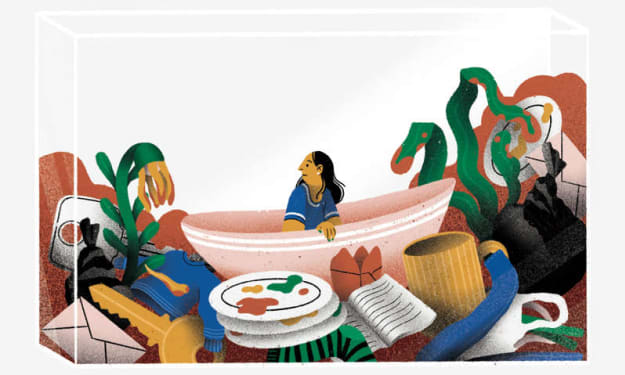What Readers Want – Series vs. Standalone Books?
I love both, but we're all different.

An author asks, “Do readers like series with the same characters or should I be looking to start fresh with each new project?” I think the answer to this question is dependent on the characters more than the readers. Do the characters still have more story for you to tell?
Or maybe the answer depends on your goals as an author. One answer is potentially the better financial decision than the other.
Or …
You get the idea. There are a lot of factors in making this decision which have nothing to do with the reader that are much more relevant in deciding what to write, at least this portion of that decision, anyway. There are significant numbers of readers who will be okay with either decision. I’ll talk a bit about what a reader is going to perceive as positive or negative with each potential choice. In my view, there are actually more than two choices. While I could subdivide them several ways, I’m going to talk in terms of four book types. I’ll start by explaining each of the four possibilities.
A True Standalone
The characters and story world are unique to this book. Nothing in this story is going to help you understand backstory or anything else in another book.Sometimes an author thinks this is what they’re writing, but when it is time to write their next book they realize they were writing the first of a series.
One Big Story
This is a series that could be viewed as a single long story, starting at one point and following the same set of characters over a period of time (also known as a serial). Understanding the import of what is happening in book #5 might require knowing about an event from book #3. While some backstory can be integrated in subsequent volumes to help clue a reader in who has started reading mid-series, there is going to be a lot that reader misses.
Several Overlapping Stories
This and the next possibility fall somewhere between the first two. While both are series, they have some of the qualities of a standalone.
This variation is a series, in that each book has the same characters and same setting as the others, but normally each book can stand alone. Each of the books in the series focuses on one or two of the characters with the others serving as secondary characters. Done well, what little backstory is needed from prior installments can be integrated into later books, so the books can be read as standalones without the reader missing anything important.
This is the only way I can picture having a series in the romance genre. Each of a group of friends experiences romance, finding their own happily-ever-after, with a seperate book for each character.
Standalone Episodes
In this kind of series each book focuses on the same protagonist. Often the setting is the same from book to book. However, each book stands alone. While the main character might change over the course of the series (growing older, more experienced, or whatever), these changes are subtle and not needed to understand the story. Reading a series like this in random order isn’t going to be much different than reading it in the order the books were written. The books in this kind of series tend to be written to a formula. (Think Nancy Drew or The Hardy Boys as examples.)
Now for the Pros and Cons
Each of these choices has some positives and negatives.
A series of the “One Big Story” type has the advantage that if a reader likes your characters, they can get more of their story. After a while it becomes comfortable, like hanging out with old friends. You know what to expect and, since you keep coming back for more, must like it. A character can change more, hopefully improving for the better, while retaining the author’s credibility if it happens over a longer period in a series. It is easier for a reader to make the commitment of time and money implied by the purchase of a new book if it is a book in a series they’ve already begun because they have a better idea of what they’re getting. If they liked the first one, they rightfully believe the odds are better of liking the next than some other random book, even another book by the same author. (This last item has some positive and negative connotations to authors in marketing and promotion of subsequent books.)
A “One Big Story” series also has some negatives from the standpoint of a reader. If each installment doesn’t have a complete and satisfying story arc of its own, they may feel left hanging while waiting for the next book. Depending on the overall story arc of the series, there may be some significant threads left unresolved that will bother a reader who has to wait for the next book. Add to that the possibility that the publisher might drop the series or a self-published author could decide not to continue it or introduce a significant delay between books for artistic or business reasons, and a reader is taking a risk committing to this kind of series (if they realize in advance). Some might not be willing. (I have one friend who has been burned so many times that she won’t start reading the first book in a series until the complete series has been released. Then, if she remembers and is still interested, she’ll binge read the entire set.)
A standalone book’s pros and cons are just the opposite of the “One Big Story” series. Less risk and commitment, but also no way to get “more of the same” if you really like the book, depending on what it is that appeals to you. The same characters, you’re certainly out of luck. Even another book of the same genre by the same author might be much different.
The two other series variations, as you’d expect, have pros and cons for a reader that fall somewhere between the standalone and “One Big Story” extremes. The risk and commitment is like a standalone. However, if you like one book, you’re able to spend additional time with the characters in subsequent books. The opportunity for growth in characters isn’t as great with this kind of series, but this is offset by not needing to start from the beginning and the option of skipping around in the series, picking the books that have plots you find most appealing based on the description. Although a series can have any number of installments, from two to hundreds, as a practical matter the “One Big Story” type has a limit (the story can’t go on forever) and the overlapping stories type is limited by the number of characters to focus on. The episodic series type can go on forever. As I mentioned above, these have a tendency to follow a formula which, if enough readers like the formula, isn’t an issue. A more likely problem is for the series to turn stale as the author, constrained by their formula and characters, runs out of unique storylines that fit.
Are We There Yet?
This is a lot of words with no definitive answer. There are readers who will be happy with any of the possible choices. There are marketing benefits as well as detriments to each for an author. My advice would be, write what you’re inspired to write, but maybe some of the discussion above will inspire something new.
If you have a question you’d like considered for our “What Readers Want” series, drop us a line by using the contact form. Please put “What Readers Want” as the subject line. Cathy and Big Al will choose from the questions submitted for future posts. Please make sure to let us know if you want to remain anonymous. If you’re lucky, they’ll both answer your question. Maybe they’ll even agree with each other.
HERE ARE SOME OF MY FAVORITE BOOKS THAT I HAVE READ OF BOTH AREAS!
1. The Selection by Kiera Cass

For thirty-five girls, the Selection is the chance of a lifetime. The opportunity to escape a rigid caste system, live in a palace, and compete for the heart of gorgeous Prince Maxon. But for America Singer, being Selected is a nightmare. It means turning her back on her secret love with Aspen, who is a caste below her, and competing for a crown she doesn’t want. Then America meets Prince Maxon—and realizes that the life she’s always dreamed of may not compare to a future she never imagined.
2. Dreamland By Sarah Dessen

Ever since she started going out with Rogerson Biscoe, Caitlin seems to have fallen into a semiconscious dreamland where nothing is quite real. Rogerson is different from anyone Caitlin has ever known. He's magnetic. He's compelling. He's dangerous. Being with him makes Caitlin forget about everything else—her missing sister, her withdrawn mother, her lackluster life. But what happens when being with Rogerson becomes a larger problem than being without him?
3. Wonderland By R.J. Palacio

August Pullman was born with a facial difference that, up until now, has prevented him from going to a mainstream school. Starting 5th grade at Beecher Prep, he wants nothing more than to be treated as an ordinary kid—but his new classmates can’t get past Auggie’s extraordinary face. Wonder, begins from Auggie’s point of view, but soon switches to include his classmates, his sister, her boyfriend, and others.
About the Creator
Ms. Thomas
Always wanted to be a writer since I was 10 years old and now that I am 22 now, I can able to write still and make my dream come true.






Comments
There are no comments for this story
Be the first to respond and start the conversation.